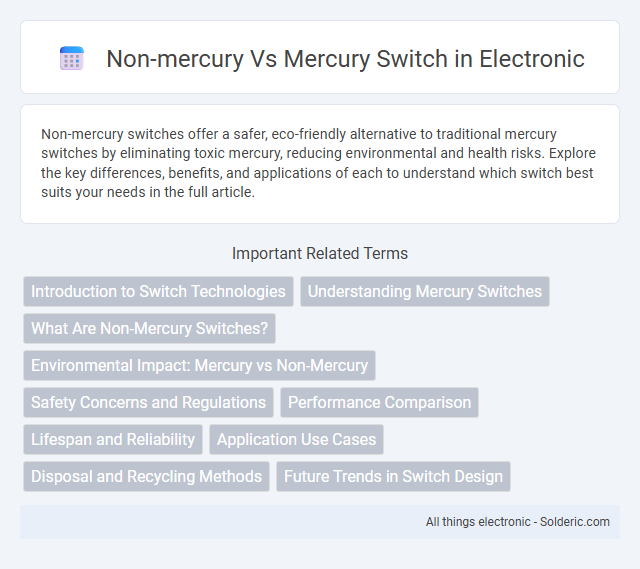Non-mercury switches offer a safer, eco-friendly alternative to traditional mercury switches by eliminating toxic mercury, reducing environmental and health risks. Explore the key differences, benefits, and applications of each to understand which switch best suits your needs in the full article.
Comparison Table
| Feature | Non-Mercury Switch | Mercury Switch |
|---|---|---|
| Material | Uses mechanical or electronic components | Contains liquid mercury |
| Environmental Impact | Eco-friendly, no toxic metals | Hazardous, toxic mercury pollution risk |
| Sensitivity | High sensitivity with modern tech | Stable and reliable sensitivity |
| Lifespan | Long-lasting with minimal wear | Durable but risks leakages over time |
| Regulatory Status | Compliant with global environmental laws | Restricted or banned in many countries |
| Applications | Used in modern appliances, automotive safety, and electronics | Previously used in thermostats, tilt sensors, and industrial controls |
Introduction to Switch Technologies
Non-mercury switches utilize alternative materials such as metal contacts or liquid metals like gallium to provide reliable conductivity without the toxic risks associated with mercury. Mercury switches have been historically favored for their stable and low-resistance electrical connections in various applications, but concerns about environmental and health impacts have led to stricter regulations and a shift toward safer alternatives. Your choice between non-mercury and mercury switch technologies should consider factors like environmental safety, electrical performance, and compliance with industry standards.
Understanding Mercury Switches
Mercury switches contain liquid mercury that completes an electrical circuit when tilted, offering reliable conductivity and durability but raising environmental and health concerns due to mercury's toxicity. Non-mercury switches use alternative materials like ball or tilt switches with metals safe for disposal, providing safer and eco-friendly options that meet modern regulatory standards. Choosing non-mercury switches helps protect your environment while maintaining efficient and stable switch operation.
What Are Non-Mercury Switches?
Non-mercury switches are electrical devices that operate without using toxic mercury, relying instead on alternatives like metal bimetallic strips or magnetic sensors to open and close circuits safely. These switches offer enhanced environmental safety and compliance with regulations that restrict mercury use, reducing health hazards and waste disposal challenges. Your choice of non-mercury switches supports sustainable practices while maintaining reliable performance in various applications.
Environmental Impact: Mercury vs Non-Mercury
Mercury switches contain toxic mercury that poses significant environmental hazards if leaked, contaminating soil and water and harming wildlife. Non-mercury switches use safer materials that eliminate the risk of mercury pollution, making them a more eco-friendly option for your projects. Choosing non-mercury switches supports sustainable practices and reduces hazardous waste management challenges.
Safety Concerns and Regulations
Non-mercury switches present significantly reduced safety risks due to the absence of toxic mercury, a hazardous substance that can cause environmental and health issues if broken or improperly disposed of. Mercury switches are heavily regulated under environmental laws such as the U.S. Mercury-Containing and Rechargeable Battery Management Act and the Minamata Convention on Mercury, which aim to limit mercury use and encourage safer alternatives. Choosing non-mercury switches helps you comply with these regulations while minimizing potential exposure to harmful mercury vapor.
Performance Comparison
Non-mercury switches provide improved environmental safety without compromising electrical performance, offering reliable switching operations with reduced risk of toxic exposure. Mercury switches deliver precise and stable contact resistance, ensuring consistent conductivity and durability under varied temperature conditions. Advances in non-mercury switch technology have closed the performance gap by enhancing contact materials and design, achieving comparable lifespan and responsiveness to traditional mercury switches.
Lifespan and Reliability
Non-mercury switches typically offer longer lifespan and improved reliability compared to mercury switches due to their solid-state or sealed mechanical designs, which reduce wear and environmental risks. Mercury switches can degrade over time as the liquid mercury evaporates or corrodes internal components, impacting their accuracy and functionality. Choosing non-mercury switches ensures your system benefits from consistent performance and compliance with modern environmental regulations.
Application Use Cases
Non-mercury switches are preferred in environmentally sensitive applications such as medical devices, aerospace systems, and automotive electronics due to their non-toxic properties and compliance with stringent environmental regulations. Mercury switches, historically used in industrial equipment and older HVAC systems, are now largely replaced because of mercury's toxicity and disposal challenges. Modern applications favor non-mercury alternatives like solid-state and reed switches to enhance safety, reliability, and sustainability.
Disposal and Recycling Methods
Non-mercury switches require different disposal and recycling methods compared to mercury switches due to their distinct chemical compositions. Mercury switches must be handled as hazardous waste to prevent toxic mercury contamination, necessitating specialized recycling facilities that safely capture and recycle the mercury. You should ensure that non-mercury switches are processed through electronic waste programs designed for non-hazardous materials, promoting safer environmental outcomes.
Future Trends in Switch Design
Future trends in switch design emphasize the shift from mercury switches to safer, eco-friendly alternatives such as solid-state and reed switches, driven by stricter environmental regulations and sustainability goals. Non-mercury switches offer enhanced durability, improved reliability, and reduced health risks, aligning with the global move toward greener technology solutions. Your choice of switch technology will increasingly favor devices that minimize toxic materials while maintaining performance efficiency.
non-mercury vs mercury switch Infographic

 solderic.com
solderic.com